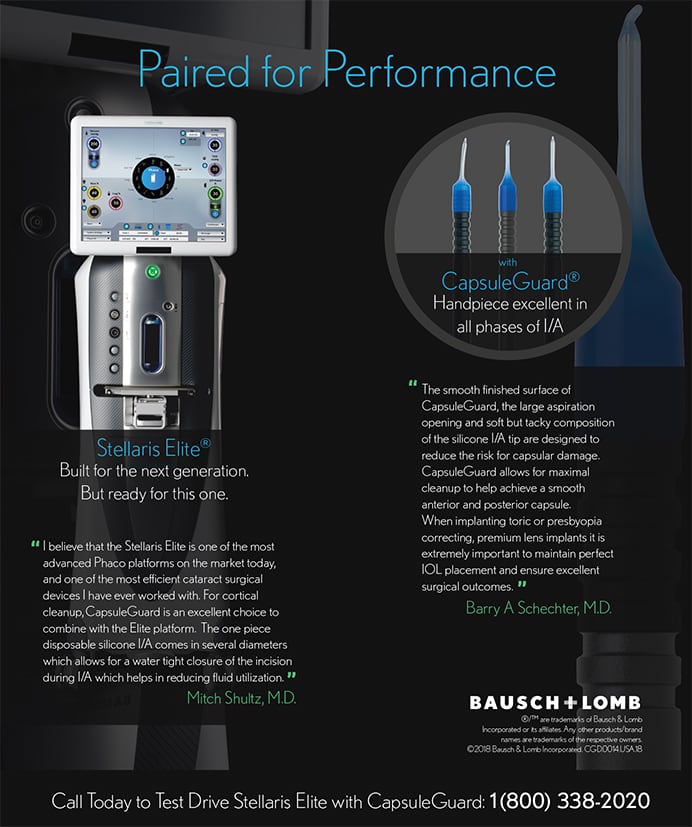Roughly 2 years ago, I noticed that underdiagnosed DED was becoming a recurring theme in the patients I was seeing, especially in my referrals presenting for cataract or refractive surgery. The patient’s cataract or refractive need often overshadowed unaddressed ocular surface disease (OSD). It’s what led me to open a dry eye clinic in my practice.
Concentration on DED started as part of the preoperative workup but quickly transitioned into a complete clinic that functions as a treatment center for DED. The clinic is not only for patients who need treatment before surgery, but also for those who are referred directly from outside providers (ODs and MDs) for specialized ocular surface care.
I quickly realized that patients with positive outcomes after treatment for DED often referred friends or family members, or they told their primary care physician, rheumatologist, or other physician, who then referred other symptomatic patients to me. This has led to increases in patients, treatments, and the bottom line of the practice.
This article outlines some of the steps I took in implementing the clinic. These are steps you too can take if you are interested in participating in this facet of eye and vision care.
Preoperative Care
A patient’s ocular surface must be healthy and stable before we obtain IOL measurements, corneal topography, and refraction; otherwise, those preoperative numbers will be erroneous, and the patient will end up unhappy. It is therefore our job as the gatekeepers of surgery to ensure that we prepare the ocular surface before referring a patient for surgery; this is inherent in our role to provide the best patient care.
To drive patients to your clinic, establish a recommended protocol for referring providers or those who are doing cataract or refractive evaluations. The goal is to screen patients and catch those who have an unstable ocular surface in order to treat the underlying disease before proceeding with surgery.
The 2017 PHACO study found that 77% of patients presenting for cataract surgery had positive corneal staining.1 If screening is done correctly, these patients with significant signs would be referred to the clinic for treatment and then sent back for surgery. This minimizes postoperative chair time as patients are happy with the results of their surgery more quickly.
Your guidelines should ensure that preoperative patients fill out a lifestyle questionnaire, such as the Standard Patient Evaluation of Eye Dryness (SPEED) or Ocular Surface Disease Index. Suggest to your evaluating providers that they order DED testing for every patient who has a specific score: for example, a SPEED score of 6 or more. This will ensure that symptomatic patients are addressed before surgery, not after. I tailor my questionnaire to include inquiries about systemic disease and environmental factors as well. Consider also including tear osmolarity measurement in your protocol.
Logistics
Once I established who would be flagged preoperatively and sent to me for treatment, I then designed my dry eye clinic flow.
You should start small, potentially with a half day a week devoted to DED patients. New patient evaluations should be scheduled for extra time, and follow-ups can be shorter. I started out with a 30-minute exam time for new patients and 15 minutes for follow-ups. As time went on, efficiency improved, and patient referrals increased, I reserved more days every week for DED.
Decide which diagnostics you will use in your workup and which treatments you plan to offer. Diagnostics such as meibography and lipid layer testing help demonstrate the mechanism of the disease and enforce the importance of intervention. Discussing meibography with your patients with MGD will encourage compliance. Do not forget about the power of a simple anterior photo; this helps patients to see their ocular surface as we see it.
Staff engagement is key. Before you start, be sure to dedicate ample time for education and hands-on learning for your employees. Once your staff members are trained, they can better discuss the nature of DED with patients and help foster an optimistic atmosphere. Their passion and interest is vital to keeping patients involved. This factor can make or break your success in a specialized clinic.
Incorporating in-office procedures such as LipiFlow Thermal Pulsation (TearScience) or iLux (Alcon) thermal lid treatments, lid debridement with Blephex (Blephex) or NuLids (NuSight Medical), or intense pulsed light treatment is key in a DED clinic. If I recommend a specific in-office treatment, I always offer to perform it on the same day to increase compliance and capture rate. I plan for this in my schedule so that it does not negatively affect patient flow.
Advertising
The main source of advertising for a dry eye clinic is word of mouth. Successfully treated DED patients will be indebted to you and will likely refer everyone they know with symptoms. They will also share their positive results with their other health care providers, such as rheumatologists, endocrinologists, and primary care practitioners, who will then refer symptomatic patients to you.
Very symptomatic DED patients are looking for practices that go above and beyond; they usually have tried other offices before. Make your clinic stand out from others by advertising that you are a Dry Eye Center of Excellence, publicizing your in-office procedures, and publishing material about OSD on your website. Industry partners can help advertise your services. For instance, if you purchase a new piece of equipment, you can advertise it using that company’s prepared press release or graphics for social media.
Include an interactive SPEED questionnaire on your website, a symptom checklist on your Facebook page, or targeted posts focused on DED. Many of my nonreferred patients have told me that they chose my office because our website had plentiful information about DED and treatment options, whereas others’ did not. Consider including communication about DED in your annual reminder emails. This will often prompt patients who would have delayed a routine exam to come in earlier.

Figure. The conversation surrounding dry eye should start prior to your optometric evaluation.
Patient Engagement
Patients should be encouraged to start thinking about DED when they first call to make an appointment (Figure). When the receptionist answers a call to book a visit, he or she should ask about DED symptoms and schedule patients who are symptomatic appropriately.
The process continues when patients arrive at your office. In your waiting room, are patients exposed to infographics and videos about DED? Subsequently, the technician should ask questions about symptomatic DED and talk with enthusiasm about the treatments you offer. Finally, in the exam lane, the patient should notice educational material about DED or in-office procedures. This way, by the time you walk into the room, he or she has already thought about DED and is open to discussion and treatment.
Collaborative Care
Collaborating with providers in your area to foster a learning and communicative environment will help launch mutually beneficial relationships. It is imperative to inform local optometrists, ophthalmologists, and other specialists about your clinic.
Send letters advertising your DED services to providers in your area. Hold a workshop or lunch-and-learn for referring ODs and MDs to demonstrate in-office procedures. Hands-on experience with DED procedures will help referring providers solidify the reasoning for and efficacy of specialized DED treatment. Provide referring surgeons with pertinent evidence such as the PHACO study as a reminder of the importance of preoperative ocular surface care.
Make sure to send letters of thanks to referring providers once you have seen their patients and let them know what treatment plan you have established.
The Impact
In my practice, I saw a major change in the number of LipiFlow treatments after starting a specialized clinic. From 2016 to 2018, our number of treatments per month increased by 250%. Revenue from in-office sales of omega-3 supplements, preservative-free tears, hot compress masks, etc., has also risen. And since introducing my focus on DED, my DED patient base has tripled.
Concentrating on a specific field such as DED can set you apart and yield success for your practice. Directing your focus will hone your skills and allow you to better care for your patients. Your patient numbers will grow dramatically once you start seeing positive results in treatment outcomes. Happy patients are your security for a fruitful DED clinic.
- Trattler WB, Majmudar PA, Donnenfeld ED, McDonald MB, Stonecipher KG, Goldberg DF. The Prospective Health Assessment of Cataract Patients’ Ocular Surface (PHACO) study: The effect of dry eye. Clin Ophthalmol. 2017;11:1423-1430.






